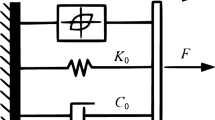Abstract
This paper presents vibration control performance of quarter car model with three-degrees-of-freedom having Magneto- Rheological (MR) suspension system. Experimental work is performed on an MR shock absorber prototype under various cyclic excitation conditions. A polynomial model is selected to characterize the test results of MR shock absorber. The designed forward fuzzy logic controller (FFLC) and inverse fuzzy logic controller (IFLC) are assembled in the secondary suspension system of quarter car model. The response plots in time domain due to bump road disturbance related to passenger seat are obtained for uncontrolled and controlled quarter car models. Simulation results are compared for selection of best option which can provide maximum ride comfort to travelling passengers. Simulation results demonstrate that semi-active quarter car system provides improved overall performance in terms of passenger ride comfort and safety compared to uncontrolled system.







Similar content being viewed by others
References
Lou Z, Ervin RD, Filisko FE (1994) A preliminary parametric study of electrorheological dampers. Trans ASME J Fluids Eng 116(3):570–576
Sassi S, Cherif K, Mezghani L, Thomas M, Kotrane A (2005) An innovative magnetorheological damper for automotive suspension: from design to experimental characterization. Smart Mater Struct 14:811–822
Nguyen QH, Choi SB (2009) Optimal design of MR shock absorber and application to vehicle suspension. Smart Mater Struct 18(3):035012
Sung KG, Choi SB (2011) Design and control of a MR shock absorber for electronic control suspension. J Korean Soc Precis Eng 28:31–39
Dong XM, Yu M, Liao CR, Chen WM (2010) Comparative research on semi-active control strategies for magneto-rheological suspension. Nonlinear Dyn 59:433–453
Zareh SH, Abbasi M, Mahdavi H, Osgouie KG (2012) Semi-active vibration control of an eleven degrees of freedom suspension system using neuro inverse model of magnetorheological dampers. J Mech Sci Technol 26(8):2459–2467
Karnopp DC, Crosby MJ, Harwood RA (1974) Vibration control using semi-active force generators. ASME J Eng Ind 96(2):619–626
Ahmadian M, Vahdati N (2006) Transient dynamics of semiactive suspensions with hybrid control. J Intell Mater Syst Struct 17(2):145–153
Eslaminasab N, Biglarbegian M, Melek WW, Golnaraghi MF (2007) A neural network based fuzzy control approach to improve ride comfort and road handling of heavy vehicles using semi-active shock absorbers. Int J Heavy Veh Syst 14(2):135–157
Yu M, Dong XM, Choi SB, Liao CR (2009) Human simulated intelligent control of vehicle suspension system with MR dampers. J Sound Vib 319(3–5):753–767
Rashid MM, Rahim NA, Hussain MA, Rahman MA (2011) Analysis and experimental study of magnetorheological-based damper for semiactive suspension system using fuzzy hybrids. IEEE Trans Ind Appl 47(2):1051–1059
Zong LH, Gong XL, Xuan SH, Guo CY (2013) Semi-active H\(\infty \) control of high speed railway vehicle suspension with magnetorheological dampers. Veh Syst Dyn 51(5):600–626
Qazi AJ, Silva CWD, Khan A, Khan MT (2014) Performance analysis of a semiactive suspension system with particle swarm optimization and fuzzy logic control. Sci World J 2014:174102
Spencer BF Jr, Dyke SJ, Sain MK, Carlson JD (1997) Phenomenological model for magnetorheological dampers. J Eng Mech ASCE 123(3):230–238
Wereley NM, Pang L, Kamath GM (1998) Idealized hysteresis modeling of electrorheological and magnetorheological dampers. J Intell Mater Syst Struct 9(8):642–649
Jimenez R, Icaza LA (2005) LuGre friction model for a magnetorheological damper. Struct Control Health Monit 12:91–116
Choi SB, Lee SK, Park YP (2001) A hysteresis model for the field-dependent damping force of a magnetorheological damper. J Sound Vib 245:375–383
Jin G, Sain MK, Spencer BE Jr (2005) Nonlinear blackbox modeling of MR-dampers for civil structural control. IEEE Trans Control Syst Technol 13:345–355
Wang DH, Liao WH (2005) Modeling and control of magnetorheological fluid dampers using neural networks. Smart Mater Struct 14(1):111–126
Du H, Lamb J, Zhang N (2006) Modelling of a magneto-rheological damper by evolving radial basis function networks. Eng Appl Artif Intell 19:869–881
Boada MJL, Calvo JA, Boada BL, Díaz V (2011) Modeling of a magnetorheological damper by recursive lazy learning. Int J Non-Linear Mech 46:479–485
Zadeh LA (1965) Fuzzy sets. Inf Control 8:338–353
Author information
Authors and Affiliations
Corresponding author
Rights and permissions
About this article
Cite this article
Devdutt, Aggarwal, M.L. Fuzzy control of passenger ride performance using MR shock absorber suspension in quarter car model. Int. J. Dynam. Control 3, 463–469 (2015). https://doi.org/10.1007/s40435-014-0128-z
Received:
Revised:
Accepted:
Published:
Issue Date:
DOI: https://doi.org/10.1007/s40435-014-0128-z




